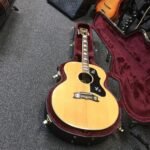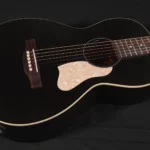What are the key differences between auditorium vs dreadnought acoustics?
Are the differences so vast that they would affect your playing style?
Which one is the right acoustic guitar for you and your style of playing?
The auditorium acoustic guitar is slightly smaller than the dreadnought. The size difference doesn’t really have a drastic effect on the sound if you’re a casual player. But if you’re a discerning acoustic player, you’ll find the auditorium is best for cutting through the mix.
So, which is better? Is it the dreadnought guitar or does the auditorium have a chance to win this comparison match?
Find out below which guitar is better in this auditorium vs dreadnought acoustics comparison.
1. Shape
The dreadnought by all accounts and purposes wins hands down in this first match as it has the “perfect” body shape for those looking for an acoustic guitar.
The dreadnought’s body shape is the first thing that comes to mind when someone mentions “acoustic guitar” in a conversation.
The auditorium, on the other hand, possesses a more modern look with pronounced curves to make it more comfortable to play.
When it comes to aesthetics, I prefer the auditorium.
But the dreadnought still wins this round simply because everyone knows what it looks like and expects all acoustic guitars to look just like it.
2. Size
The dreadnought is the standard against which all other acoustic guitars are measured.
In terms of size, the dreadnought has the perfect measurement from neck to body.
The auditorium is just a smidge smaller than the dreadnought.
In fact, if not for its curvy shape, it would be easy to mistake an auditorium for a dreadnought.
Here are the technical measurements between Auditorium Vs. Dreadnought Acoustics
| Measure | Dreadnought | Auditorium |
| Total Body Length | 20 inches | 19.04 inches |
| Lower Bout Measurement | 15.6 inches | 15 |
| Upper Bout Measurement | 11.5 inches | 11.25 inches |
| Body Depth | 4.6 inches | 4.12 inches |
Size only matters if you’re thinking of comfort.
A small person can find ways to play a dreadnought but it will never be as comfortable as playing an auditorium.
So, since the size difference is negligible, the dreadnought wins this round.
3. Volume
A bigger, deeper body means a louder sound.
Therefore, the dreadnought wins this round.
The auditorium has a slightly smaller chamber due to its shallower depth and more pronounced curves.
What this does is push the sound to the middle, thereby making the “mids” more pronounced.
So, while the dreadnought has a larger overall sound, the auditorium has a more pronounced mid sound.
In truth, the auditorium can sound just as loud as a dreadnought if you strum it hard enough.
The results will be jarring but if you learn the proper technique, you can pluck this guitar hard and still sound pleasing to the ear.
This round is a draw with a slight upper hand given to the dreadnought for its effortless ability to sound loud.
4. Tone
There’s a reason why the dreadnought continues to be the preferred guitar by guitarists: it is a complete guitar.
You hear the bass, the mid, and the treble with the dreadnought.
And it all comes out of the sound hole perfectly mixed for your personal or professional entertainment purposes.
The auditorium on the other hand has a slightly more pronounced mid than the dreadnought.
This is due to the shallow chamber which immediately pushes out the mids while keeping the bass and treble slightly behind.
To be quite honest, there’s not much difference between the two if you’re simply listening to it being played.
The difference becomes more apparent when you’re the one playing it.
You’ll find that you will need a more focused pick attack to keep the auditorium from inadvertently ringing out all the time.
But, if you’re looking for a way to stand out in the mix, plucking the auditorium’s strings with a deliberate technique will make it sing.
All you have to do is pick it hard with a plectrum or your fingers and quickly lighten the pressure to control how much it rings out.
This will take years of practice but it’s worth it when you learn how to do it. Both guitars win this round.
5. Target Users
Dreadnoughts are the bread-and-butter instrument for musicians.
Its full, rich sound is inspiring to keep playing with and pleasing to the ear of listeners who happen to pass by.
It is a full entertainment device that you can use for personal or professional purposes.
The auditorium on the other hand has a more select audience. It is for guitarists who prefer their mids to stand out when playing alone or in the mix.
This requires a more deliberate attack to bring out the richness of the sound when you pluck it.
This can usually be done with a hard downstroke and progressive lightening of the pressure as the pick or finger escapes the string.
So, if you’re a regular strummer, go for the dreadnought.
If you’re a more technical player, you can bring a lot of great tonal goodies out of the auditorium.
Target users for the auditorium can also be those who are smaller or have smaller hands and want a guitar they can play with easily.
The sound between auditorium vs dreadnought acoustics isn’t too far off which would make it noticeable to regular ears.
Which One Should You Get?
If you’re only looking for an acoustic guitar that fills the need to make music, then the dreadnought is perfect.
But if you’re looking for a specific sound that features a lot of mid and is clear enough to stand out of the mix without totally jumping out, then the auditorium is perfect for you.
The dreadnought is a complete guitar that features all of the tones you’d want when you play it.
The bass is present, there’s enough mid and treble, and the notes linger long enough in the chamber before coming out as a full, rich sound that everyone automatically associates with the sound of a proper acoustic guitar.
The auditorium is obviously an evolution of the Orchestra Model which makes it the most modern among all of the representatives of the acoustic guitar line.
But then again, a guitar will only feel right when you have it in your hands and you hear and feel the sound it makes when you pluck or strum the strings.
As a smaller player, you may want to choose the auditorium over the dreadnought although the size difference isn’t that glaring.

Hello there, my name is Ramiro and I’ve been playing guitar for almost 20 years. I’m obsessed with everything gear-related and I thought it might be worth sharing it. From guitars, pedals, amps, and synths to studio gear and production tips, I hope you find what I post here useful, and I’ll try my best to keep it entertaining also.





